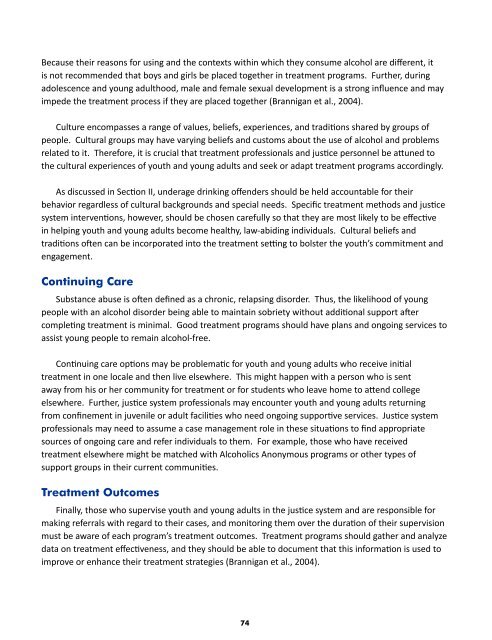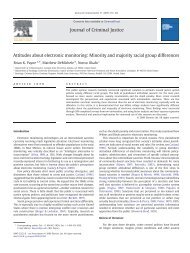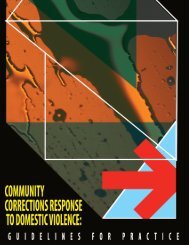Intervention Principles and Practice Guidelines for - Underage ...
Intervention Principles and Practice Guidelines for - Underage ...
Intervention Principles and Practice Guidelines for - Underage ...
Create successful ePaper yourself
Turn your PDF publications into a flip-book with our unique Google optimized e-Paper software.
Because their reasons <strong>for</strong> using <strong>and</strong> the contexts within which they consume alcohol are different, it<br />
is not recommended that boys <strong>and</strong> girls be placed together in treatment programs. Further, during<br />
adolescence <strong>and</strong> young adulthood, male <strong>and</strong> female sexual development is a strong influence <strong>and</strong> may<br />
impede the treatment process if they are placed together (Brannigan et al., 2004).<br />
Culture encompasses a range of values, beliefs, experiences, <strong>and</strong> traditions shared by groups of<br />
people. Cultural groups may have varying beliefs <strong>and</strong> customs about the use of alcohol <strong>and</strong> problems<br />
related to it. There<strong>for</strong>e, it is crucial that treatment professionals <strong>and</strong> justice personnel be attuned to<br />
the cultural experiences of youth <strong>and</strong> young adults <strong>and</strong> seek or adapt treatment programs accordingly.<br />
As discussed in Section II, underage drinking offenders should be held accountable <strong>for</strong> their<br />
behavior regardless of cultural backgrounds <strong>and</strong> special needs. Specific treatment methods <strong>and</strong> justice<br />
system interventions, however, should be chosen carefully so that they are most likely to be effective<br />
in helping youth <strong>and</strong> young adults become healthy, law-abiding individuals. Cultural beliefs <strong>and</strong><br />
traditions often can be incorporated into the treatment setting to bolster the youth’s commitment <strong>and</strong><br />
engagement.<br />
Continuing Care<br />
Substance abuse is often defined as a chronic, relapsing disorder. Thus, the likelihood of young<br />
people with an alcohol disorder being able to maintain sobriety without additional support after<br />
completing treatment is minimal. Good treatment programs should have plans <strong>and</strong> ongoing services to<br />
assist young people to remain alcohol-free.<br />
Continuing care options may be problematic <strong>for</strong> youth <strong>and</strong> young adults who receive initial<br />
treatment in one locale <strong>and</strong> then live elsewhere. This might happen with a person who is sent<br />
away from his or her community <strong>for</strong> treatment or <strong>for</strong> students who leave home to attend college<br />
elsewhere. Further, justice system professionals may encounter youth <strong>and</strong> young adults returning<br />
from confinement in juvenile or adult facilities who need ongoing supportive services. Justice system<br />
professionals may need to assume a case management role in these situations to find appropriate<br />
sources of ongoing care <strong>and</strong> refer individuals to them. For example, those who have received<br />
treatment elsewhere might be matched with Alcoholics Anonymous programs or other types of<br />
support groups in their current communities.<br />
Treatment Outcomes<br />
Finally, those who supervise youth <strong>and</strong> young adults in the justice system <strong>and</strong> are responsible <strong>for</strong><br />
making referrals with regard to their cases, <strong>and</strong> monitoring them over the duration of their supervision<br />
must be aware of each program’s treatment outcomes. Treatment programs should gather <strong>and</strong> analyze<br />
data on treatment effectiveness, <strong>and</strong> they should be able to document that this in<strong>for</strong>mation is used to<br />
improve or enhance their treatment strategies (Brannigan et al., 2004).<br />
74

















